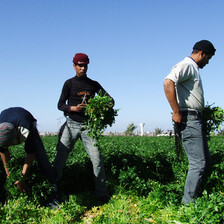al-Faraheen, Gaza Strip 17 August 2007

Palestinians inspect the wreckage of what used to be their home after it was destroyed during an Israeli military incursion in the southern Gaza Strip, 14 August 2007. (Wissam Nassar/MaanImages)
Surveillance cameras and watchtowers loom over more than 800 meters away from the scene of destruction left by Israeli army tanks and bulldozers following the latest Israeli invasion of the al-Faraheen area in Abbassan al-Kabeera town, to the east of Khan Younis in the southern Gaza Strip.
“Fifteen dunums [four acres] of tomatoes along with 400 meters of irrigation pipes were crushed by the Israeli tanks during the invasion into our area, where myself and two other partners make our living,” says Samir al-Naqa, a local farmer in the al-Faraheen area.
Samir affirms that the invasion took place in the middle of the day. “I’d bet whether there was a single resistance fighter in the area; I’d bet the Israeli army whether there is a single tunnel in the area. It’s our land, through which we feed our children. Where to go, we have no other choice, despite the fact they invaded the area about four times this year.”
Israeli media quoted sources who claimed that the invasion was a bid to prevent Palestinian attempts to smuggle weapons through underground tunnels.
When one walks down the arable lands in al-Faraheen, following Tuesday’s invasion, one is struck by the sight of heaps of torn apart olive trees, dead tomato vines and holes in nearby walls thanks to the Israeli tanks that wreaked the destruction ostensibly in pursuit of resistance fighters or in search of underground tunnels.
Almost 800 meters away lies a long barbed-wire fence that separates al-Faraheen from Israel. This fence is equipped with surveillance cameras and watchtowers, in a way that not only prevents infiltrators but also discovers any moving object.
“I hope there was a single tunnel that Israel can destroy; we have been living here for ages. All their allegations are false ones,” says Anwar Abu Daqqa, a 43-year-old landlord.
Anwar gave a tour of the areas where the Israeli army tanks rolled through, including a newly-built graveyard that was damaged by the tanks.
“Look, sir, I am in charge of this small cemetery; how come the tank rolls over graveyards — are they tunnels? Are there resistance fighters hidden inside? I really wonder and I bet whether a single resistance fighter can come to our closed area. Many times I myself prevented resistance fighters from approaching the area, for concern over our children’s lives,” Anwar maintains.
Anwar himself lost 30 cows during an Israeli invasion into al-Faraheen last year when the Israeli army remained in the area for 24 hours, so he decided to sell the rest of his livestock.
Heading deep inside the populated area, there is another scene of destruction created by Israeli tanks and shells — a completely destroyed three-story house, where the Israeli army killed two resistance fighters of Hamas along with the 70-year-old mother of one of them.
Mohammad Qdaih, an eyewitness, recalls the events. “When the army shot dead Omar al-Qarra, Omar’s mother rushed to her son out of her great concern. However, the Israeli soldiers shot her dead over Omar’s body.”
Safa’ Braim, a local woman, described the Israeli invasion. “They were [the Israelis] shooting at the houses heavily and randomly. We could not even look from the windows. This is not the first time that they invade our area; what we need now is that they stop their aggression against us and leave us and our children to live safely at least.”
Tuesday’s Israeli invasion into the al-Faraheen area in southern Gaza claimed the lives of seven Palestinians, including an elderly woman and two resistance fighters, and caused the injury of more than 35 others, including five who are critically wounded.
According to local sources, the area has been invaded five or six times over the past year and a half and each time, tanks have left behind horror, destruction and death.
Rami Almeghari is currently contributor to several media outlets including the Palestine Chronicle, aljazeerah.info, IMEMC, The Electronic Intifada and Free Speech Radio News. Rami is also a former senior English translator at and editor in chief of the international press center of the Gaza-based Palestinian Information Service. He can be contacted at rami_almeghari at hotmail.com.
Related Links





